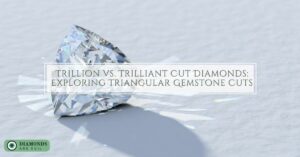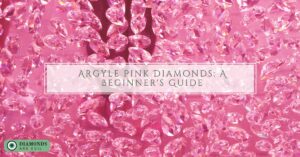Introduction
The invention of lab-grown diamonds started in the 1950s due to the increasing demand for the diamond, and the available sources were no longer enough to satisfy the booming market. Lab-grown diamonds are replicas of natural diamonds, which were formed 1 billion to 3.3 billion years before their discovery. Natural diamonds are created from atoms of carbon, which are in the Earth’s core. Atoms of carbons that are in close proximity bond together in covalent bonding, and thereby forming strong, hard, durable and crystalline structures.
Natural diamonds are formed in the Earth’s core under extreme temperature and pressure 1oo miles below the Earth’s surface. They are moved up to a few kilometers in the lithosphere, where they can now be accessed by the mining process by volcanic eruptions. The necessary conditions for the formation of natural diamonds are now being replicated in controlled laboratory environments, which now led to the creation of lab-grown diamonds, which are also referred to as man-made diamonds, lab-created diamonds and synthetic diamonds.
There have been some arguments and debates on the authenticity of lab-grown diamonds against natural diamonds. Most traditionalists who believe in natural diamonds argue that lab-grown diamonds are not genuine because it’s not from a natural source. However, both natural diamonds and lab-grown diamonds have the same optical, refraction, physical, and chemical properties, which means there is no difference in both types of diamonds; therefore, they are both genuine diamonds.
Factors that need to be considered when buying diamonds
Diamonds are not just known for their beauty and aesthetics, but they are also used as a sign of romance, love, and commitment. They are properly used in the production of engagement rings, wedding rings, bracelets, necklaces, and other jewelry.
Therefore, necessary factors need to be considered when purchasing natural and lab-grown diamonds, and they are; the diamond 4c’s (carat, color, clarity, and cut), diamond shape, and diamond certificates.
Carat
Diamonds are measured by gemologists in metric carats. A carat is equivalent to 200 milligrams. Diamonds weight are mostly listed in carat or fraction of a carat.
Color
Colors of diamonds are rated on a scale of D (colorless) to Z (light yellow) because only a small percentage of the diamond is colorless. The most expensive ones are the colorless diamond.
Clarity
Diamonds have internal inclusion and external blemish. Therefore, clarity refers to the imperfections which are found in diamonds based on their number, type, and position.
Cut
The reaction of a diamond to light depends on the way its face and angles are cut in order to improve its reflection of light. When a diamond is not efficiently cut, it will dull, whereas a diamond with brilliant angles reacts well to light to give brightness.
Diamond shape
Diamonds are designed to have different shapes of which the round cut is most valued and priced because of its brilliance. Other shapes of a diamond are marquise, heart, oval, cushion, and other fancy shapes.
Fluorescence
Only a small percentage of diamonds gives a faint blue glow when exposed to ultra-violet rays in the sunlight, approximately 25 to 30% of diamonds. Although the fluorescence nature of diamonds is not easily noticed with the naked eyes, it can make diamonds look hazy when it is too much.
Certificates
Purchasing diamonds with necessary certificates is one of the best ways to ensure quality whereby its cut, carat, and clarity are listed out. The main diamond labs include the Gemological Institute of America (GIA), the International Gemological Institute (IGI), and Hoge Raid Voor Diamante (HRD).
Benefits of lab-grown diamonds over its natural counterpart
Lab-grown diamonds have a lot of benefits over its natural friend, which makes it a desirable choice of diamond, and it includes the following:
- Eco-friendly
- Source’s credibility
- Improved quality and purity
- Budget efficient and sustainable
- Affordable colored stones
- Technology advancement
Eco-friendly
The mining process involved in extracting natural diamonds usually involves a large volume of excavation or dirt removal just to find 1 carat of diamond. Diamond mines are some of the largest mining holes that are dug in the Earth, and mining involves a large proportion of fossils fuels as a source of energy, which results in pollution.
These mining activities can result in different environmental hazards like earthquakes, deforestation, erosion, landslide, climate change, and other indirect adverse effects on humanity. However, lab-grown diamonds have little or no environmental impact on the environment and humanity.
Source Credibility
Lab-grown diamonds are of credible source than natural diamonds because their manufacturers are known, and you are sure of its origin. Natural diamonds have vague and indistinct sources. They are mostly found in conflict zones of the world, and some diamonds are sold to fund these conflicts. This resulted in the theory of “blood diamond”. However, in non-conflict areas, diamond mining has been related to child labor, human rights violation, and poor or inhumane working conditions.
Improved quality and purity
Lab-grown diamonds are usually whiter, brighter, and of higher quality than natural diamonds. Natural diamonds are mined from the ground, which makes it prone to impurities, unlike lab-grown diamonds.
Budget efficient and sustainable
Natural diamonds are usually very expensive and rare, but with the creation of lab-grown diamonds, diamonds are now produced in large quantities. Diamonds are more available and affordable, saving up to 10-30% on lab-grown diamonds.
Affordable colored stones
Natural colored diamonds are rare and are therefore very expensive to buy. However, lab-grown colored diamonds are easy to find, less expensive, purer, and steady in color than their natural counterparts.
Technological advancement
Lab-grown diamonds are created by cutting edge technology which allows growing diamonds under controlled laboratory conditions. Therefore, as scientists continue to research these techniques, these will lead to more advancement in the production of lab-grown diamonds.
Uses of diamonds
Lab-grown diamonds and natural diamonds have the same application and use in diamond relevant industries because both have the same physical and chemical properties. Majorly, diamonds are used as earrings, engagement ring, pendant, wedding ring, and other jewelry. However, there are other uses of diamonds, and it includes the following:
- Industrial use: Due to the hard structure of diamonds, they are used for industrial purposes such as cutting, polishing, drilling, mining, etc. They are added to saw edges to make them stronger and more effective.
- Electronics: Diamonds are used in the design of speaker domes, which produce high-quality sound.
- Health: The use of tiny particles of diamonds, which is referred to as Nanodiamonds, is used in the treatment of cancer.
- In computers: Recent research has revealed that diamond enhanced semi-conductors have made electric current in computers more effective, faster, and lighter.
- Diamonds are also used as beauty products.
Conclusion
It is necessary to know that the decision to buy a lab-grown diamond is solely that of the buyer, and there is no need to feel pressure when it comes to the choice of selection. However, either natural diamonds or lab-grown diamonds are both genuine, authentic, and can serve the same purpose. It is also worthy of note to understand that encouraging the use of lab-grown diamonds preserves the Earth’s ecosystem.






